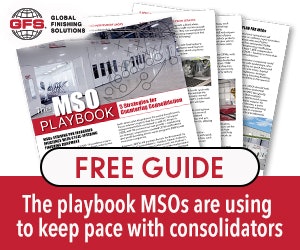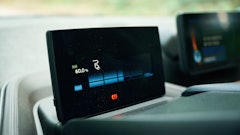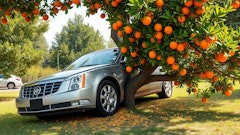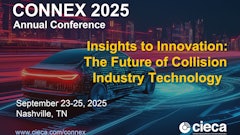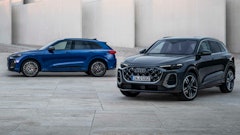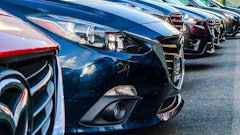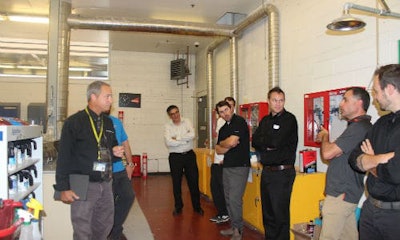
Dave Samalea of Centennial College conducts a tour of the school's autobody labs. Centennial College served as host for the Toyota Collision Repair Conference.
By Mike Davey
Toronto, Ontario — August 26, 2016 — The importance of scanning in modern collision repair was reinforced a number of times during the Toyota Collision Repair Conference. The event took place at Toronto’s Centennial College.
Toyota Canada hosted body shop stakeholders and collision repair wholesalers for a day-long educational session. Bruno Bonazza, Central Zone Parts and Service Manager, led off the day with a warm welcome and special thanks to Centennial College for assisting with this event. He also gave an overview of Toyota in Canada and some information about the number of Dealers and units in operation in the province of Ontario.
Next up was Paul Stella, Collision Repair and Refinish Manager, with an outline of what attendees could expect, including information on Toyota Recommended Repair Procedures, the Toyota Certified Collision Centre program, the CollisionLink tool, tips and resources for Toyota collision repair and a discussion of scan tools.
A short video detailed some of the manufacturing processes in use at Toyota’s plant in Kentucky. You can check out this video in the player below. After the video, Stella noted that Toyota’s plant in Cambridge, Ont., offers tours open to the public where you can see many of these same processes in action.
Next up was an in-depth discussion of Toyota Recommended Repair Procedures, accessed through Mitchell Ultramate. The focus was on the importance of arriving at an accurate estimate and using Toyota’s recommended procedures for the repair. The system not only provides the correct procedure, but is also linked to any tech bulletins and repair procedures that might exist on the topic.
The topic of single-use parts was discussed; leading to a comment from an audience member that some insurers had indicated to him that they would not pay for every nut, bolt and other non-reusable part.
Stella noted that single-use parts have been in use by Toyota and other OEMs for years, but Toyota has recently stepped up its efforts to communicate this to the industry. This has obviously resulted in some friction between repairers and insurers. Stella mentioned that another session would be scheduled for insurers to receive education on this and the other topics under discussion during the conference.
Stella then showed a short video on Toyota Safety Sense, an advanced driver assistance system (ADAS). This led directly into a discussion of the importance of recalibrating those systems after a collision and the need to perform scans, both pre- and post-repair.
Stella outlined a number of information sources available online that had noted the importance of scanning, including Collision Repair magazine and I-CAR. Stella also pointed to a recent panel discussion at NACE 2016 on the importance of scanning. The panel was moderated by Mike Anderson of Collision Advice, who has long been a proponent of the importance of scanning. The panelists were representatives of various OEMs. It’s worth noting that every single participating manufacturer agreed that you must scan the vehicle both before and after the repair to ensure all systems are calibrated and the repairs completed properly.
One of the attendees brought up resistance he had received to this idea from insurers.
“We need to start having those discussions with our insurance partners,” said Stella.
Stella discussed the proliferation of various advanced safety systems, noting than even budget-priced models like the Corolla would soon have automatic braking systems. This means an increase in sensors in the car. It’s relatively easy for an external sensor to become damaged in an accident. It falls to repair professionals to repair or replace these sensors as needed to ensure the system works correctly. This again highlights the importance of scanning in the modern repair process.
The meeting broke for a tour of the autobody labs at Centennial College, led by Dave Samalea
of Centennial College.
After the tour, Stella discussed what he sees as a crucial difference between an aftermarket scan tool and the Toyota factory scan tool, Techstream.
Stella said. “When we come out with the 2017 Corolla in a couple of weeks, all of the information will already be loaded into our scan tool.” Another important point that he mentioned is that Toyota does not test the aftermarket scan tool so he could not comment on their performance.
The full dealership version of Techstream sells for around $6,000. However, a Techstream Lite kit is available for significantly less. This consists of a MongoosePro MFC Interface cable coupled with a subscription to the diagnostic service. When the interface cable is hooked to a laptop, it provides the same functionality as the dealership version.
Stella then looked at specific instances of single-use parts, referring to a recent Collision Repair magazine article that presented Toyota’s stance on the issue. Stella noted that many gaskets, hardware and other items are designed to be used only once. They must be replaced, not reused.
After lunch, Dave Samalea of Centennial College presented on some of the autobody and related programs at Centennial College at both the apprenticeship and diploma level, including the Parts Technician Apprenticeship and the Automotive Parts & Service Operations, a brand-new post-secondary diploma program that starts in 2017.
Samalea also noted that students today have the same number of hours to devote to education as they did 20 years ago, but that vehicles are significantly more complex. This leads to a need to identify people with the right aptitude as early as possible.
“We’ve got to find the people who have the right skills, nurture them and bring them along,” he said.
Steve Giffin, Area Parts & Service Manager in Central Zone, then gave a presentation on the Toyota Smart Parts program. The program is powered by CollisionLink software. Giffin focused on the details and philosophy behind the program. In short, the program is designed to be competitive on price with aftermarket parts.
Giffin pointed out that they do not purposefully restrict parts from this program. In fact, he told attendees there are over 183,000 parts currently on the program and new parts are added frequently.
“The program is price-competitive, and that allows body shops to convert aftermarket parts to OEM parts nine times out of 10,” said Giffin.
Chris Rae, Manager Parts Supply Toyota, discussed the company’s part distribution network, including improvements that Toyota has made recently, such as the addition of new staff.
Stella then returned to the front of the room for the final presentation of the day, outlining some of the free technical resources that Toyota provides online through crrtraining.com. The site is intended for the US market but provides a wealth of information, including access to Toyota’s Collision Repair Information Bulletins (CRIBS) and Toyota’s in-house publication, Collision Pros. The site also contains vital safety information, such as steps to take when working on hybrids, and other relevant information. Stella also summarized other sources of information, such as I-CAR.
He then discussed the Toyota Certified Collision Centre program. Stella provided some history of the program, noting that the original program looked at 18 different areas. One thing it did not do, however, was keep track of a changing industry. The program is currently being revamped to keep up with vehicle technology and industry trends.
Some changes being studied to the program are tools and equipment, training, process, access to technical information to name a few. A welder, for example, must be capable of performing certain operations and meet other standards. The actual brand purchased, however, is up to the repairer.
Actually becoming a Toyota Certified Collision Centre, however, doesn’t just mean having equipment that can get the job done. A dealership sponsorship is absolutely essential for any independent repair centre that wants to participate. There’s also a significant amount of training that must be completed as well.
For more information on Toyota Canada, please visit toyota.ca.
{unitegallery Toyota_Collision_Repair_Conference}

